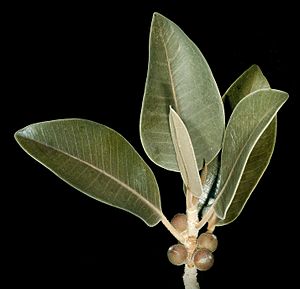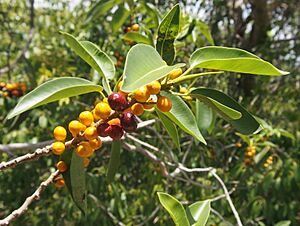Desert fig facts for kids
Quick facts for kids Desert fig |
|
|---|---|
 |
|
 |
|
| Scientific classification | |
| Kingdom: | |
| (unranked): | |
| (unranked): | |
| (unranked): | |
| Order: | |
| Family: | |
| Genus: | |
| Species: |
F. platypoda
|
| Binomial name | |
| Ficus platypoda (Miq.) A. Cunn. ex Miq.
|
|
| Synonyms | |
|
Urostigma platypodum Miq. |
|
Ficus platypoda, often called the desert fig or rock fig, is a type of fig tree. It grows only in central and northern Australia. This special plant is a lithophytic plant, which means it loves to grow right on rocky outcrops. It can grow quite tall, sometimes reaching up to 10 meters (about 33 feet) high!
Contents
What is a Desert Fig? (Taxonomy)
Every living thing has a scientific name, like Ficus platypoda for the desert fig. This helps scientists around the world know exactly which plant they are talking about.
A Dutch botanist named Friedrich Anton Wilhelm Miquel first described the desert fig in 1847. He gave it the name Urostigma platypodum. He studied plants collected from both the east and west coasts of Australia. The plants collected by Allan Cunningham from York Sound in Western Australia were very important for identifying this species.
For a while, there was some confusion, and the plant was also called Ficus leucotricha. However, because Ficus platypoda was the older name, it became the accepted scientific name we use today.
Scientists sometimes look at the DNA of plants to understand them better. In 2001, scientists studied the different groups of Ficus platypoda. They found that some plants thought to be Ficus platypoda were actually different species! Because of this, Ficus brachypoda, Ficus atricha, and Ficus cerasicarpa were named as their own separate species.
The Ficus group is huge, with over 750 different species. It's one of the largest groups of flowering plants! Scientists like to organize these plants into smaller groups to make them easier to study. Ficus platypoda belongs to a specific group called Urostigma.
More recently, in 2008, scientists used DNA sequences to study the Ficus group even more closely. They found that Ficus platypoda is closely related to two other fig species from the Northern Territory: F. subpuberula and F. lilliputiana. These three species likely grew in drier areas over time.
How to Identify a Desert Fig (Description)
The Ficus platypoda can grow as a shrub or a tree, reaching up to 10 meters (33 feet) tall. Its small branches are covered in fine, soft hairs.
The leaves grow one after another along the stems. They are usually oval-shaped, about 5 to 17 centimeters (2 to 6.5 inches) long and 3 to 13 centimeters (1 to 5 inches) wide. The underside of the leaves feels furry.
The figs (the fruit of the tree) are oval or round. They can be many colors when they ripen, including yellow, orange, pink, red, or purple. They are usually about 1 to 3 centimeters (0.4 to 1.1 inches) long and 1 to 3 centimeters (0.4 to 1.1 inches) across.
Where Desert Figs Grow (Distribution and Habitat)
You can find Ficus platypoda across the northern part of Australia, known as the Top End. This includes the Gulf Country near the Gulf of Carpentaria, all the way through the Northern Territory, and into northern Western Australia.
It usually grows on sandstone rocks. Sometimes, it can also be found on limestone rocks.
Desert Fig's Friends (Ecology)
The rock fig has a special relationship with a tiny wasp. A specific type of wasp, called Pleistodontes cuneatus, helps to pollinate the fig. This means the wasp helps the fig tree make seeds so new fig trees can grow.
How People Use Desert Figs (Uses)
The fruit of the desert fig can be eaten when it is soft and ripe.
This plant is also popular for bonsai. Bonsai is the art of growing small trees in containers. The desert fig is good for bonsai because it naturally forms a wide base for its trunk and has small leaves. These features make it very attractive for bonsai artists. Some Ficus platypoda bonsai trees have even been shown in exhibitions!
See also
 In Spanish: Ficus platypoda para niños
In Spanish: Ficus platypoda para niños


